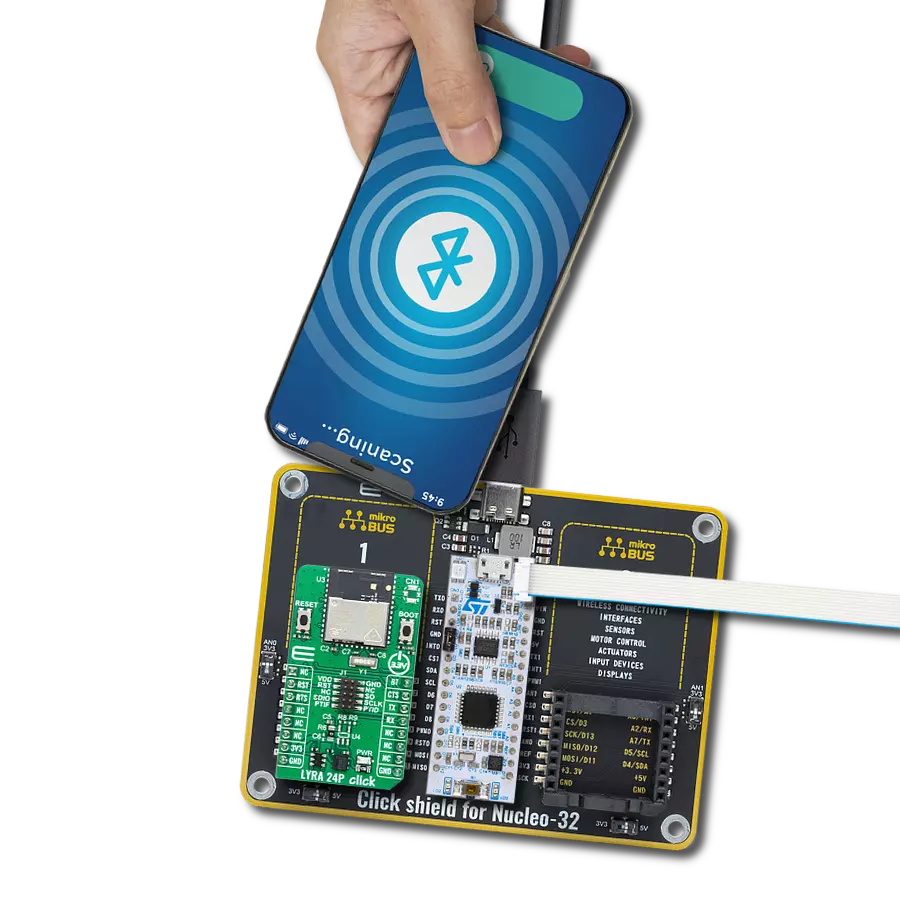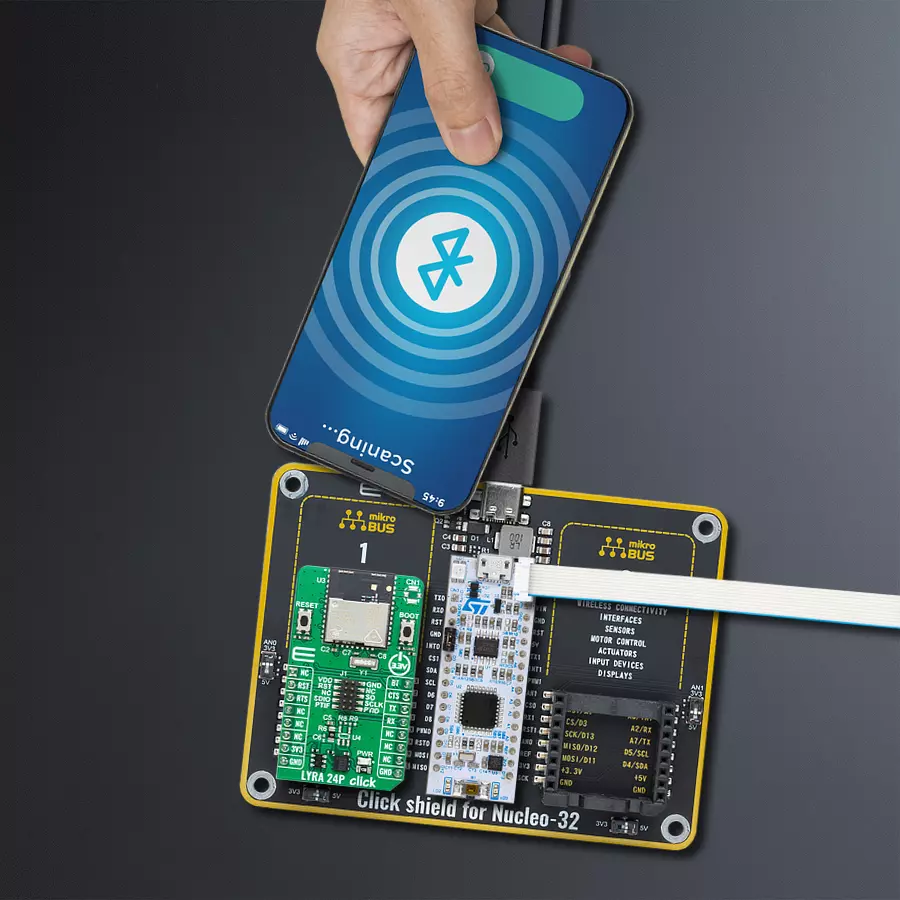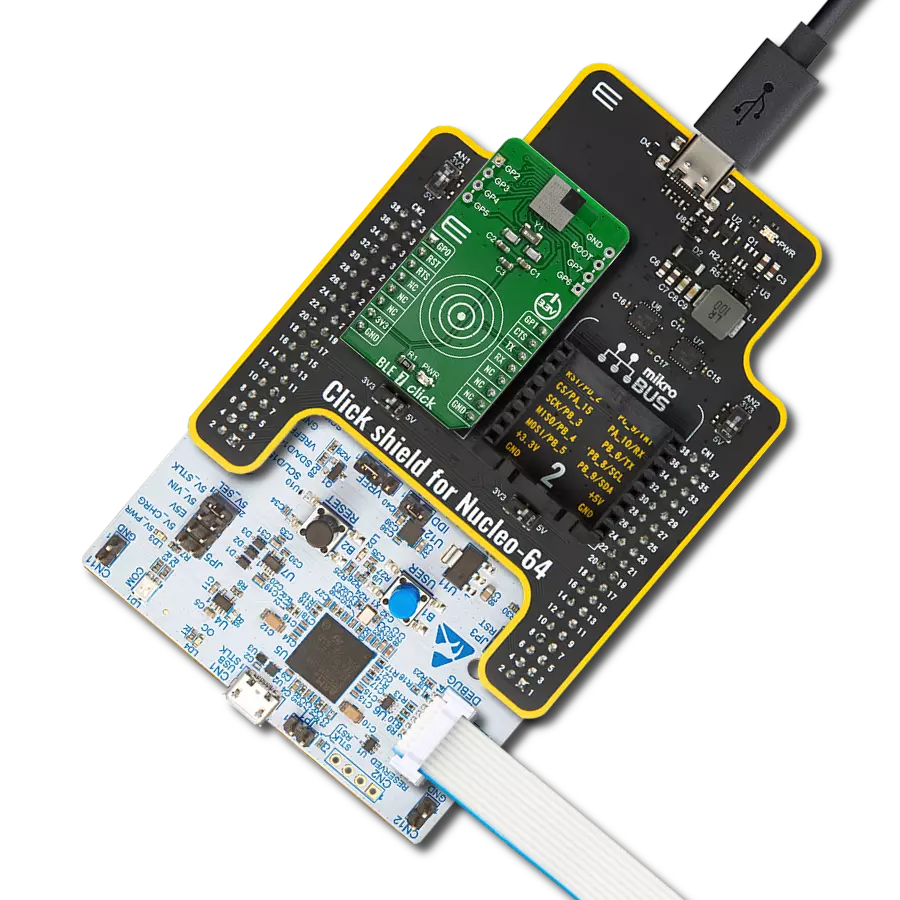Provide high-performance and secure Bluetooth Low Energy (BLE) 5.3 wireless connectivity for various Internet-of-Things (IoT) applications
A
A
Hardware Overview
How does it work?
LYRA 24P Click is based on the LYRA 24P (453-00145R), a secure, high-performance wireless module from Ezurio designed for line-powered IoT devices operating on Bluetooth networks. The LYRA 24P module is a highly integrated, high-performance system with all the necessary hardware components to enable 2.4GHz wireless connectivity. Based on the Series 2 EFR32BG24 SoC (32-bit ARM® Cortex®-M33 core at 39MHz), it enables Bluetooth® Low Energy (BLE) 5.3 connectivity, delivering exceptional RF performance and energy efficiency (+19.6dBm TX output power). It features industry-leading Secure Vault® technology (Lyra 24P module supports Secure Vault High) and futureproofing capabilities. Secure Vault is a collection of technologies providing state-of-the-art security and upgradability features to protect and futureproof IoT devices against costly threats, attacks, and tampering. A dedicated security CPU enables the Secure Vault functions, isolating cryptographic functions and data from the Cortex-M33 core. The LYRA 24P is a complete solution that offers fully upgradeable software stacks and global regulatory certifications. It is suitable for a broad range of applications, including
smart home devices, lighting, building automation and security, gateways, digital assistants, and Bluetooth mesh low-power nodes. The main module power supply is 3.3V from the 3V3 mikroBUS™ power rail, automatically supplied via the R6 resistor. It can also be powered via the AP7331, a fixed-3.3V output voltage low-dropout linear regulator. This Click board™ is based on the 453-00145R module but is also compatible with other LYRA 24P modules. The module includes a built-in antenna and operates in the 2.4GHz ISM frequency band, from 2402 to 2480MHz. Additionally, it has an unpopulated connector for an external 2.4GHz antenna connection, suitable for module variants with an RF pin for an external antenna only, such as the 453-00148. Communication between the LYRA 24P and the host MCU is established through a UART interface, using standard UART RX and TX pins and hardware flow control pins (CTS/RTS). The module communicates at 115200bps by default, allowing efficient data exchange. The board also includes a reset (RST) button/pin for resetting the module and a Boot (BT) button/pin used to determine when execution of the bootloader is required. Upon
reset, execution of the bootloader begins. When the Boot button is pressed, the bootloader continues execution, facilitating firmware updates via the UART. When released, the bootloader stops execution and passes control to the main application firmware. The LYRA 24P also supports hardware debugging via a 4-pin JTAG or 2-pin serial-wire debug (SWD) interface through the J1 header. This header includes two additional pins, the PTIF and PTID pins, providing a true PHY-level packet trace interface that captures packets non-intrusively to monitor and log device and network traffic without burdening processing resources in the module's SoC. These signals are a powerful debugging tool, especially when used with other hardware and software development tools. This Click board™ can be operated only with a 3.3V logic voltage level. The board must perform appropriate logic voltage level conversion before using MCUs with different logic levels. Also, it comes equipped with a library containing functions and an example code that can be used as a reference for further development.
Features overview
Development board
Nucleo 32 with STM32F031K6 MCU board provides an affordable and flexible platform for experimenting with STM32 microcontrollers in 32-pin packages. Featuring Arduino™ Nano connectivity, it allows easy expansion with specialized shields, while being mbed-enabled for seamless integration with online resources. The
board includes an on-board ST-LINK/V2-1 debugger/programmer, supporting USB reenumeration with three interfaces: Virtual Com port, mass storage, and debug port. It offers a flexible power supply through either USB VBUS or an external source. Additionally, it includes three LEDs (LD1 for USB communication, LD2 for power,
and LD3 as a user LED) and a reset push button. The STM32 Nucleo-32 board is supported by various Integrated Development Environments (IDEs) such as IAR™, Keil®, and GCC-based IDEs like AC6 SW4STM32, making it a versatile tool for developers.
Microcontroller Overview
MCU Card / MCU

Architecture
ARM Cortex-M0
MCU Memory (KB)
32
Silicon Vendor
STMicroelectronics
Pin count
32
RAM (Bytes)
4096
You complete me!
Accessories
Click Shield for Nucleo-32 is the perfect way to expand your development board's functionalities with STM32 Nucleo-32 pinout. The Click Shield for Nucleo-32 provides two mikroBUS™ sockets to add any functionality from our ever-growing range of Click boards™. We are fully stocked with everything, from sensors and WiFi transceivers to motor control and audio amplifiers. The Click Shield for Nucleo-32 is compatible with the STM32 Nucleo-32 board, providing an affordable and flexible way for users to try out new ideas and quickly create prototypes with any STM32 microcontrollers, choosing from the various combinations of performance, power consumption, and features. The STM32 Nucleo-32 boards do not require any separate probe as they integrate the ST-LINK/V2-1 debugger/programmer and come with the STM32 comprehensive software HAL library and various packaged software examples. This development platform provides users with an effortless and common way to combine the STM32 Nucleo-32 footprint compatible board with their favorite Click boards™ in their upcoming projects.
Used MCU Pins
mikroBUS™ mapper
Take a closer look
Click board™ Schematic

Step by step
Project assembly
Track your results in real time
Application Output
1. Application Output - In Debug mode, the 'Application Output' window enables real-time data monitoring, offering direct insight into execution results. Ensure proper data display by configuring the environment correctly using the provided tutorial.

2. UART Terminal - Use the UART Terminal to monitor data transmission via a USB to UART converter, allowing direct communication between the Click board™ and your development system. Configure the baud rate and other serial settings according to your project's requirements to ensure proper functionality. For step-by-step setup instructions, refer to the provided tutorial.

3. Plot Output - The Plot feature offers a powerful way to visualize real-time sensor data, enabling trend analysis, debugging, and comparison of multiple data points. To set it up correctly, follow the provided tutorial, which includes a step-by-step example of using the Plot feature to display Click board™ readings. To use the Plot feature in your code, use the function: plot(*insert_graph_name*, variable_name);. This is a general format, and it is up to the user to replace 'insert_graph_name' with the actual graph name and 'variable_name' with the parameter to be displayed.

Software Support
Library Description
This library contains API for LYRA 24P Click driver.
Key functions:
lyra24p_write_command- This function writes a desired command by using UART serial interface.lyra24p_write_cmd_param- This function writes a desired command, command value, prefix and parameter by using UART serial interface.lyra24p_inquire_command- This function writes a desired inquire command, command value and enable/disable quote by using UART serial interface.
Open Source
Code example
The complete application code and a ready-to-use project are available through the NECTO Studio Package Manager for direct installation in the NECTO Studio. The application code can also be found on the MIKROE GitHub account.
/*!
* @file main.c
* @brief LYRA 24P Click Example.
*
* # Description
* This example demonstrates the use of LYRA 24P Click board by processing
* the incoming data and displaying them on the USB UART.
*
* The demo application is composed of two sections :
*
* ## Application Init
* Initializes the driver and performs a factory reset.
* In the next step, the demo app requests the LYRA module name, software version,
* and MAC address and sets the local device name,
* sets the module into VSP mode and start advertising.
*
*
* ## Application Task
* Reads and processes all incoming data and displays them on the USB UART.
*
* ## Additional Function
* - static void lyra24p_clear_app_buf ( void )
* - static void lyra24p_log_app_buf ( void )
* - static err_t lyra24p_process ( lyra24p_t *ctx )
* - static void lyra24p_check_response ( uint8_t *rsp )
*
* @note
* We have used the BLE Scanner smartphone application for the test.
*
* @author Nenad Filipovic
*
*/
#include "board.h"
#include "log.h"
#include "lyra24p.h"
// Demo device name
#define DEVICE_NAME "LYRA 24P Click"
// Application buffer size
#define APP_BUFFER_SIZE 200
#define PROCESS_BUFFER_SIZE 200
// Response timeout
#define RESPONSE_TIMEOUT 100000
static lyra24p_t lyra24p;
static log_t logger;
static uint8_t app_buf[ APP_BUFFER_SIZE ] = { 0 };
static int32_t app_buf_len = 0;
/**
* @brief LYRA 24P clearing application buffer.
* @details This function clears memory of application buffer and reset its length.
* @note None.
*/
static void lyra24p_clear_app_buf ( void );
/**
* @brief LYRA 24P log application buffer.
* @details This function logs data from application buffer to USB UART.
* @note None.
*/
static void lyra24p_log_app_buf ( void );
/**
* @brief LYRA 24P data reading function.
* @details This function reads data from device and concatenates data to application buffer.
* @param[in] ctx : Click context object.
* See #lyra24p_t object definition for detailed explanation.
* @return @li @c 0 - Read some data.
* @li @c -1 - Nothing is read.
* See #err_t definition for detailed explanation.
* @note None.
*/
static err_t lyra24p_process ( lyra24p_t *ctx );
/**
* @brief LYRA 24P response check.
* @details This function checks for response and displays the status of response.
* @param[in] rsp Expected response.
* @return Nothing.
*/
static void lyra24p_check_response ( uint8_t *rsp );
void application_init ( void )
{
log_cfg_t log_cfg; /**< Logger config object. */
lyra24p_cfg_t lyra24p_cfg; /**< Click config object. */
/**
* Logger initialization.
* Default baud rate: 115200
* Default log level: LOG_LEVEL_DEBUG
* @note If USB_UART_RX and USB_UART_TX
* are defined as HAL_PIN_NC, you will
* need to define them manually for log to work.
* See @b LOG_MAP_USB_UART macro definition for detailed explanation.
*/
LOG_MAP_USB_UART( log_cfg );
log_init( &logger, &log_cfg );
log_info( &logger, " Application Init " );
// Click initialization.
lyra24p_cfg_setup( &lyra24p_cfg );
LYRA24P_MAP_MIKROBUS( lyra24p_cfg, MIKROBUS_1 );
if ( UART_ERROR == lyra24p_init( &lyra24p, &lyra24p_cfg ) )
{
log_error( &logger, " Communication init." );
for ( ; ; );
}
lyra24p_hw_reset( &lyra24p );
Delay_ms ( 500 );
lyra24p_write_command( &lyra24p, LYRA24P_CMD_AT );
lyra24p_check_response( LYRA24P_RSP_OK );
Delay_ms ( 500 );
lyra24p_write_command( &lyra24p, LYRA24P_CMD_AT );
lyra24p_check_response( LYRA24P_RSP_OK );
Delay_ms ( 500 );
lyra24p_inquire_command( &lyra24p, LYRA24P_CMD_ATI,
LYRA24P_ATI_ARG_DEV_NAME,
LYRA24P_QUERY_DIS );
lyra24p_check_response( LYRA24P_RSP_OK );
Delay_ms ( 500 );
lyra24p_inquire_command( &lyra24p, LYRA24P_CMD_ATI,
LYRA24P_ATI_ARG_FW_VER,
LYRA24P_QUERY_DIS );
lyra24p_check_response( LYRA24P_RSP_OK );
Delay_ms ( 500 );
lyra24p_inquire_command( &lyra24p, LYRA24P_CMD_ATI,
LYRA24P_ATI_ARG_BT_ADDR,
LYRA24P_QUERY_DIS );
lyra24p_check_response( LYRA24P_RSP_OK );
Delay_ms ( 500 );
lyra24p_write_cmd_param( &lyra24p, LYRA24P_CMD_ATS,
LYRA24P_ATS_ARG_DEVNAME_FORMAT,
LYRA24P_PREFIX_SYMBOL_SET_VAL,
LYRA24P_ATS_VAL_DEVNAME );
lyra24p_check_response( LYRA24P_RSP_OK );
Delay_ms ( 500 );
lyra24p_set_device_name( &lyra24p, DEVICE_NAME );
lyra24p_check_response( LYRA24P_RSP_OK );
Delay_ms ( 500 );
lyra24p_inquire_command( &lyra24p, LYRA24P_CMD_ATPS,
LYRA24P_PREFIX_SYMBOL_ZERO,
LYRA24P_QUERY_EN );
lyra24p_check_response( LYRA24P_RSP_OK );
Delay_ms ( 500 );
lyra24p_write_command( &lyra24p, LYRA24P_CMD_ATLADV );
lyra24p_check_response( LYRA24P_RSP_OK );
Delay_ms ( 500 );
lyra24p_write_command( &lyra24p, LYRA24P_CMD_ATLVSP );
lyra24p_check_response( LYRA24P_RSP_OK );
Delay_ms ( 500 );
}
void application_task ( void )
{
if ( LYRA24P_OK == lyra24p_process( &lyra24p ) )
{
lyra24p_log_app_buf( );
lyra24p_clear_app_buf( );
Delay_ms ( 100 );
}
}
int main ( void )
{
/* Do not remove this line or clock might not be set correctly. */
#ifdef PREINIT_SUPPORTED
preinit();
#endif
application_init( );
for ( ; ; )
{
application_task( );
}
return 0;
}
static void lyra24p_clear_app_buf ( void )
{
memset( app_buf, 0, app_buf_len );
app_buf_len = 0;
}
static void lyra24p_log_app_buf ( void )
{
for ( int32_t buf_cnt = 0; buf_cnt < app_buf_len; buf_cnt++ )
{
log_printf( &logger, "%c", app_buf[ buf_cnt ] );
}
}
static err_t lyra24p_process ( lyra24p_t *ctx )
{
uint8_t rx_buf[ PROCESS_BUFFER_SIZE ] = { 0 };
int32_t overflow_bytes = 0;
int32_t rx_cnt = 0;
int32_t rx_size = lyra24p_generic_read( ctx, rx_buf, PROCESS_BUFFER_SIZE );
if ( ( rx_size > 0 ) && ( rx_size <= APP_BUFFER_SIZE ) )
{
if ( ( app_buf_len + rx_size ) > APP_BUFFER_SIZE )
{
overflow_bytes = ( app_buf_len + rx_size ) - APP_BUFFER_SIZE;
app_buf_len = APP_BUFFER_SIZE - rx_size;
memmove ( app_buf, &app_buf[ overflow_bytes ], app_buf_len );
memset ( &app_buf[ app_buf_len ], 0, overflow_bytes );
}
for ( rx_cnt = 0; rx_cnt < rx_size; rx_cnt++ )
{
if ( rx_buf[ rx_cnt ] )
{
app_buf[ app_buf_len++ ] = rx_buf[ rx_cnt ];
}
}
return LYRA24P_OK;
}
return LYRA24P_ERROR;
}
static void lyra24p_check_response ( uint8_t *rsp )
{
uint32_t timeout_cnt = 0;
lyra24p_clear_app_buf( );
lyra24p_process( &lyra24p );
while ( ( 0 == strstr( app_buf, rsp ) ) &&
( 0 == strstr( app_buf, LYRA24P_RSP_ERROR ) ) )
{
lyra24p_process( &lyra24p );
if ( timeout_cnt++ > RESPONSE_TIMEOUT )
{
lyra24p_clear_app_buf( );
log_error( &logger, " Timeout!" );
}
Delay_ms ( 1 );
}
Delay_ms ( 100 );
lyra24p_process( &lyra24p );
if ( strstr( app_buf, rsp ) )
{
lyra24p_log_app_buf( );
}
else if ( strstr( app_buf, LYRA24P_RSP_ERROR ) )
{
log_error( &logger, " Command!" );
}
else
{
log_error( &logger, " Unknown!" );
}
}
// ------------------------------------------------------------------------ END



































